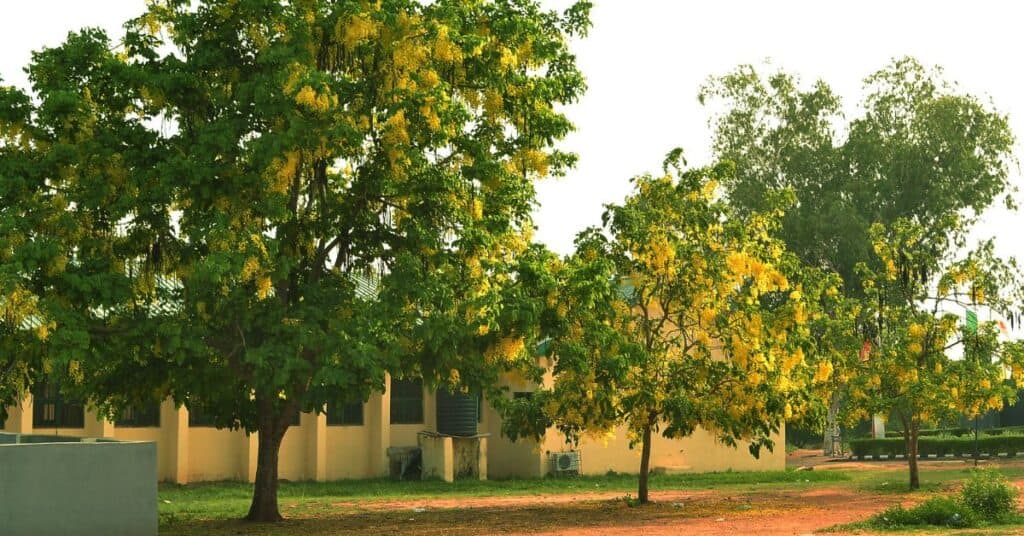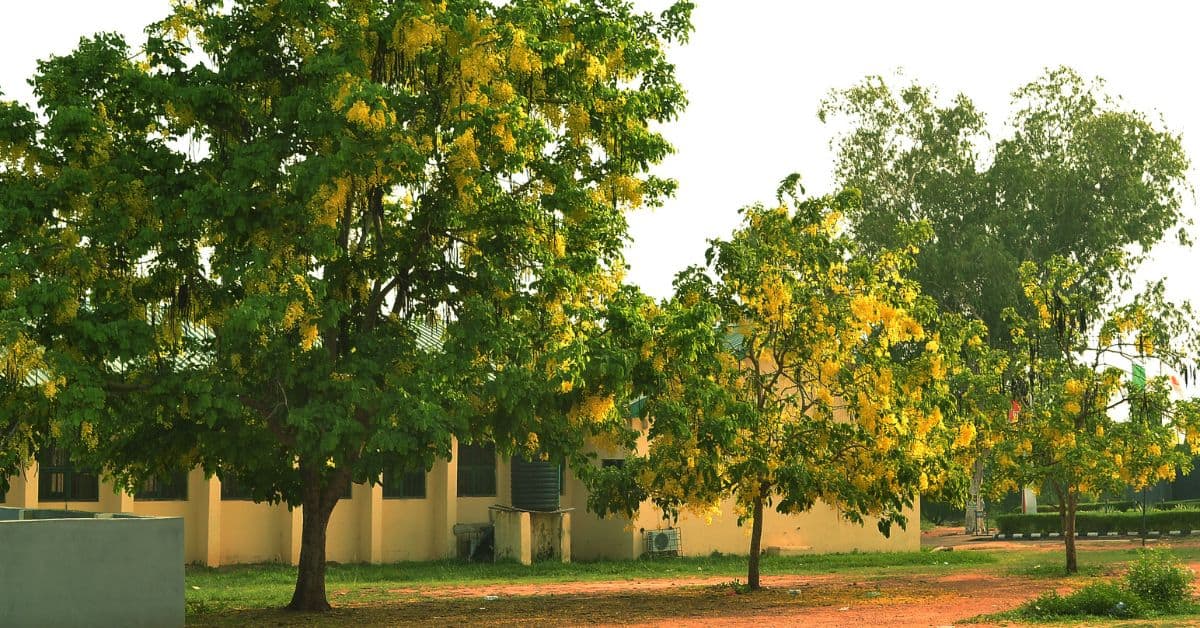Have you ever seen yellow flowering tropical trees? You’re in for a treat if so! Today, while I was on an official visit to one of my school faculty, I was attracted by the yellow blossoms of the cassia fistula tree blossoms right in the corridor of the computer laboratory.
One reason I wrote this article today is the beauty of the flower captured on my phone. Join me as we take a walk to find some of the most beautiful yellow flowering tropical trees that can be found worldwide.
We’ll look at their distinctive characteristics, growing needs, and other fascinating details, from the well-known African tulip tree to the fragrant golden shower tree. So, take your camera, and let’s adventure in the tropics!
The Significance and Symbolism of Yellow Flowers in Nature
As the hue of the sun, yellow is frequently thought to be warm, joyful, and happy. Yellow flowers are widely favored by both gardeners and nature lovers, which is surprising. Yellow flowers in the wild draw pollinators like bees, butterflies, and birds that aid in spreading plant species.
In some civilizations, yellow flowers also have symbolic implications. For instance, yellow roses in Western culture signify joy and friendliness, but yellow chrysanthemums in Chinese culture denote grandeur and longevity. Tropical trees with yellow flowers are not an exception when it comes to the meaning and symbolism of yellow flowers.
These tree’s blossoms are not only lovely, but they also provide insects and birds with nectar and pollen. The flowers stand out in any scene due to their vivid yellow hue contrasting with the trees’ luxuriant green leaves. Tropical trees with yellow flowers are common options for landscaping designs and home decor because they symbolize wealth and luck in various cultures.
What Tropical Trees Have Yellow Blossoms
There are numerous kinds and varieties of yellow flowering tropical trees, each with distinctive traits and qualities. Here below are some of the most well-known tropical trees with yellow flowers that you should be aware of:
- Spathodea campanulate: a tree native to tropical Africa, is distinguished by its sizable, vivid orange-yellow flowers that resemble tulips, and butterflies are attracted by the flowers’ clustered blooms. The 80-foot-tall African Tulip Tree needs full sun and light shade to thrive.
- Cassia fistula: commonly known as the Golden Shower Tree or Indian Laburnum, is a striking tropical tree celebrated for its vibrant and eye-catching yellow flowers.
Cassia fistula is best known for its pendulous clusters of bright yellow flowers. The flowers typically appear in large, drooping racemes, with each individual petal radiating a warm, sunny yellow hue. The vivid and abundant flowers make Cassia fistula a favorite ornamental tree in tropical regions.
- Golden Shower Tree (Cassia fistula): is a tree with Southeast Asian roots well-known for its spectacular, pendulous yellow flowers resembling a golden shower. Birds, Bees, and butterflies are attracted to the flowers when they bloom in the spring and summer. The Golden Shower Tree needs full light and well-drained soil to thrive and reach heights up to 60 feet.
- Yellow Poui (Tabebuia chrysotricha): This South American native tree is well-known for its springtime bright yellow trumpet-shaped flowers. Bees and butterflies savor the necters in their flowers, and a variety of birds call the tree home. The Yellow Poui can reach a height of 50 feet and needs full light and well-drained soil to thrive.
- Yellow Tabebuia (Tabebuia ochracea): Pink trumpet is another name for the Yellow Tabebuia (Tabebuia ochracea), a tree native to the Caribbean and South America. Its trumpet-shaped blossoms, which come in various colors from yellow to pink, gave rise to its name. The springtime blooming of the Yellow Tabebuia draws bees, butterflies, and birds. With well-drained soil and full sun, the tree grows to its maximum height of 50 feet.
- Golden Chain Tree (Laburnum anagyroides): This small deciduous tree features long cascading chains of yellow flowers, creating a stunning visual display.
- Golden Rain Tree (Koelreuteria paniculata): A medium-sized tree with clusters of yellow flowers, it adds a vibrant touch to gardens during the summer months.
- Yellow Magnolia (Magnolia acuminata): A magnificent tree with large yellow blossoms that grace its branches in early spring, adding elegance to any landscape.
- Golden Trumpet Tree (Tabebuia chrysantha): This tropical tree showcases trumpet-shaped yellow flowers that create a breathtaking display in the spring.
- Yellow Elder (Tecoma stans): With its trumpet-shaped yellow flowers, this flowering shrub adds a splash of vibrant color to gardens and landscapes.
- Yellow Poinciana (Peltophorum pterocarpum): A majestic tree with clusters of bright yellow flowers resembling large pom-poms, it’s a stunning addition to warm-climate gardens.
- Mimosa (Albizia julibrissin): Known for its delicate, fern-like foliage and fluffy yellow flowers, this tree adds a touch of elegance to gardens.
- Yellow Bird of Paradise (Caesalpinia gilliesii): This shrub features striking clusters of yellow-orange flowers that resemble a bird in flight, adding a tropical touch to landscapes.

The Best Locations to Find Yellow Flowering Tropical Trees
Tropical trees with yellow flowers can be found worldwide, from the Americas to Africa and Asia. Greatest places to locate these trees are:
- Costa Rica – Home to many yellow flowering tropical trees, including the African Tulip Tree and the Yellow Poui, Costa Rica is known for its tropical climate and diverse ecosystems.
- Thailand – is well-known for its unusual plants and animals, including the Golden Shower Tree, which serves as the country’s emblem and national flower.
- Brazil – is home to various yellow flowering tropical trees, such as the Yellow Tabebuia and the Golden Trumpet Tree. Brazil is known for its lush rainforests and savannas.
- South Africa – The African Tulip Tree, a well-liked street tree in many towns, is native to South Africa, a country renowned for its breathtaking scenery and unique species.
How to Identify Yellow Flowering Tropical Trees
Tropical trees with yellow flowers might be difficult to identify, especially to a novice who is unfamiliar with the species. There are a few crucial characteristics to watch out for, though:
- Blossoms: Their most noticeable feature is the vivid yellow blossoms of yellow flowering tropical trees. Look for tiny to large blooms with a trumpet or tulip shape.
- Leaves: Tropical trees with yellow flowers often have broad, glossy shinning leaves that are a deep shade of green. Depending on the species, look for simple or compound leaves.
- Bark: These species of ornamental trees have bark that ranges in texture and color from smooth and light to rough and black.
- Growth Habit: The tree’s growth habit should be observed because it might range from upright and symmetrical to sprawling and uneven.
The Benefits of Planting Yellow Flowering Tropical Trees
Tropical trees with yellow flowers can have various advantages for the environment and people. Here are some of such benefits:
- Ecological Benefits – It offer significant ecological advantages such as wildlife food, shelter, and shade. They also aid in lowering soil erosion and enhancing air quality.
- Aesthetic Benefits: Tropical trees with yellow flowers give a splash of color and visual intrigue to any scene. They can also raise property values and improve a neighborhood or community’s aesthetic appeal.
- Economic Advantages: Yellow-flowered ornamental trees can provide timber and other forest products, among other economic advantages. Additionally, they can draw tourists and boost local companies’ profits.
The Challenges of Growing and Maintaining Yellow Flowering Tropical Trees
Tropical trees with yellow flowers can be difficult to grow and manage, especially if you are unfamiliar with the species. Among the principal difficulties are:
- Climate Requirements: Yellow flowering trees need a warm, humid climate, which might not be appropriate for all places.
- Soil Requirements: Tropical trees with yellow flowers need well-drained soil high in organic matter. They might also need particular nutrient and pH levels in the soil.
- Pest and Disease Control: Scale insects, leaf spots, and other pests and diseases can affect tropical trees with yellow flowers. Their attractive scents invite lovers like insects, which can, in turn damage their delicate parts.
- Pruning and Maintenance: Pruning and upkeep are necessary for your trees to encourage healthy growth and guard against storms or other environmental damage.
Tips for Taking Care of Your Yellow Flowering Tropical Trees
Some great tips are needed to maintain the health and longevity of your yellow flowering tropical trees. With the following few suggestions:
- Choose a yellow-flowered tropical tree species adapted to your region’s climate and soil characteristics from a reputable local tree nursery.
- Choose the Right Site for Your Tree: Choose a spot with full sun exposure and well-drained soil where you can plant your choice of yellow flower.
- Routinely Water and Fertilize:- To encourage healthy growth, routinely water your yellow-blooming tropical tree and fertilize it with a balanced fertilizer.
- Pruning and Upkeep: Regularly pruning your tree will help prevent disease and remove any dead or damaged branches.
The Importance of Preserving These Trees in Their Natural Habitat
Most tropical trees that have yellow flowers are not only lovely and useful, but they also contribute significantly to the ecosystem. Unfortunately, deforestation, habitat loss, and other human activities put many of these tree species in danger.
If you wish to maintain biodiversity and guarantee the survival of these significant species, it is imperative to protect yellow flower trees in their native habitat. We can all contribute to the preservation and protection of these trees by encouraging sustainable land-use policies and supporting conservation initiatives.
Conclusion
Tropical trees with yellow flowers are a true wonder of nature. Their vivid yellow blossoms provide any landscape with a splash of color, and their ecological advantages significantly benefit the environment and wildlife.
Discovering the splendor of yellow blossoming tropical trees is a journey worth pursuing, regardless of your level of experience with nature or interest.
So, grab your camera and venture outside to explore the breathtaking world of tropical trees with yellow flowers!

